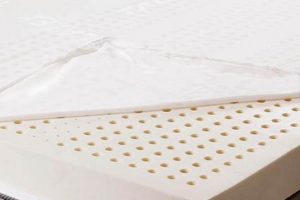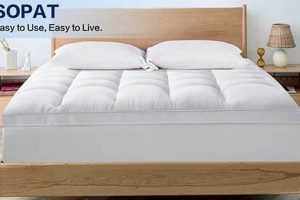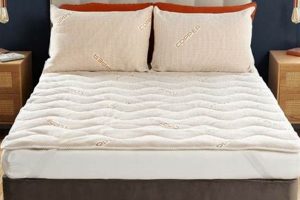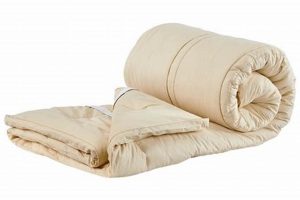A polyurethane foam bedding accessory bearing the CertiPUR-US certification indicates that the foam component has undergone rigorous testing by an independent laboratory. This assessment verifies the product’s compliance with specific standards concerning content, emissions, and durability. Such a product may be used to enhance comfort and support on an existing bed.
The value of such a certified item lies in the assurance it provides to consumers regarding potential health and environmental impacts. The certification process limits the use of certain potentially harmful substances often found in conventional foam production, such as ozone depleters, certain flame retardants, heavy metals, and formaldehyde. This can provide peace of mind for individuals sensitive to chemical exposure and contribute to more sustainable consumption practices. The emergence of these certifications reflects a growing demand for transparency and accountability in the bedding industry.
The following sections will delve deeper into the specific criteria assessed during the certification process, explore the implications of using certified foam in sleep products, and provide guidance on selecting a bedding accessory that aligns with individual needs and preferences.
Selecting a Mattress Topper
The following tips provide guidance when choosing a bedding accessory designed to enhance sleep quality while prioritizing health and environmental considerations.
Tip 1: Verify Certification Validity: Always confirm the authenticity of the CertiPUR-US certification. Reputable manufacturers will display the certification mark and provide access to verification resources on their website or product packaging. Contact CertiPUR-US directly if uncertainty exists.
Tip 2: Scrutinize Material Composition: Although the foam component may be certified, investigate the materials used in the cover and any additional layers. Opt for fabrics and fillings that are also certified organic or demonstrate adherence to similar safety standards.
Tip 3: Evaluate Density and Thickness: A higher-density foam tends to provide greater support and durability. Consider the thickness of the topper based on individual comfort preferences and the condition of the underlying mattress.
Tip 4: Assess Odor Emission: New foam products may exhibit a slight odor upon initial unboxing. Allow the topper to air out in a well-ventilated area for several days before use. A persistent or strong odor may indicate non-compliant materials.
Tip 5: Review Warranty and Return Policies: Prioritize manufacturers offering comprehensive warranties and flexible return policies. This provides recourse in the event of manufacturing defects or dissatisfaction with the product’s performance.
Tip 6: Consider Third-Party Reviews: While manufacturer claims are important, supplement research with independent customer reviews to gain a more comprehensive understanding of product performance and longevity.
Adhering to these guidelines facilitates the selection of a bedding accessory that promotes restful sleep while minimizing exposure to potentially harmful substances.
The subsequent sections will further explore the long-term implications of incorporating certified bedding products into a comprehensive sleep hygiene strategy.
1. Certified Foam Composition
Certified foam composition forms the fundamental basis of a bedding accessory identified as a “certipur us mattress topper.” The CertiPUR-US program subjects polyurethane foam used in such toppers to independent laboratory testing, ensuring it meets specific criteria. The composition is assessed for the absence or restricted use of substances such as ozone depleters, certain flame retardants, mercury, lead, and other heavy metals. The certification thereby confirms that the foam’s chemical makeup adheres to predefined standards intended to minimize potential health and environmental impacts. Failure to meet these compositional standards disqualifies a product from bearing the CertiPUR-US label.
The importance of certified foam composition is directly linked to consumer health and well-being. Conventional foam production often involves chemicals with potential adverse effects. Through independent testing and certification, consumers can confidently select a foam bedding accessory knowing its composition has been rigorously vetted. For example, a topper with certified foam composition assures a reduced risk of exposure to volatile organic compounds (VOCs), which can contribute to indoor air pollution and respiratory irritation. This level of assurance is particularly relevant for individuals with sensitivities or allergies. Such certification assures compliance with permissible limits on formaldehyde emissions, a known irritant and potential carcinogen.
In summary, certified foam composition is an indispensable aspect of a “certipur us mattress topper.” It serves as a tangible indicator of adherence to established safety standards, contributing to a healthier sleep environment and promoting informed purchasing decisions. The commitment to rigorous testing and certification provides assurance regarding the foams chemical makeup, addressing concerns related to potential health and environmental impacts. The link between composition and the label underscores the practical significance of this understanding for consumers prioritizing both comfort and safety in their bedding choices.
2. Emission Standard Compliance
Emission standard compliance constitutes a critical aspect of the CertiPUR-US certification process for bedding accessories, including those marketed as mattress toppers. This compliance focuses on the limitation and control of Volatile Organic Compounds (VOCs) released from the polyurethane foam. These compounds, emitted as gases from certain solids or liquids, can contribute to indoor air pollution and potentially adverse health effects. The CertiPUR-US program mandates rigorous testing to ensure foam products meet specific emission thresholds. This serves as a preventative measure against excessive VOC release into the sleep environment.
The practical significance of emission standard compliance is readily apparent when considering the enclosed nature of a sleeping space. VOCs emitted from a mattress topper are more likely to concentrate within the confines of a bedroom, leading to prolonged exposure for the occupant. By adhering to stringent emission standards, a CertiPUR-US certified mattress topper mitigates this risk. For example, the certification process involves testing for substances like formaldehyde, a known irritant. Compliance with emission standards ensures that formaldehyde levels remain within acceptable limits, minimizing potential respiratory irritation or other adverse reactions. This has an impact on sleep quality.
In conclusion, emission s
tandard compliance, as an integral part of the CertiPUR-US certification, offers a crucial layer of protection for consumers. It addresses the potential for VOC emissions from polyurethane foam mattress toppers, ensuring that products meet established safety benchmarks. By prioritizing adherence to these emission standards, the CertiPUR-US program contributes to a healthier indoor environment and promotes greater consumer confidence in the safety of certified bedding products. This focus on emission control highlights the commitment to protecting public health, making emission standard compliance paramount.
3. Durability Testing Protocol
The “Durability Testing Protocol” forms a critical component of the CertiPUR-US certification for mattress toppers. This protocol subjects foam products to a series of standardized tests designed to simulate real-world use and assess their capacity to withstand degradation over time. Such testing protocols measure various parameters, including indentation force deflection (IFD) loss, fatigue resistance, and height loss after repeated compression cycles. These tests are designed to predict how well the foam will maintain its support and comfort characteristics throughout its expected lifespan. The integrity of a foam, and consequently, the mattress topper as a whole, directly depends on its demonstrated durability under this rigorous testing regimen.
The practical implications of a robust “Durability Testing Protocol” for consumers are significant. For example, a topper exhibiting minimal IFD loss after extended compression testing will likely provide consistent support and pressure relief for a longer duration than one that degrades more rapidly. A diminished “Durability Testing Protocol” can result in premature sagging, reduced comfort, and the need for replacement, leading to increased costs and environmental impact. The existence of a standardized, independently verified “Durability Testing Protocol” provides consumers with confidence that a “certipur us mattress topper” has been assessed for long-term performance, and not solely for initial comfort characteristics. Testing to failure points gives consumers valuable metrics.
In summary, “Durability Testing Protocol” is a fundamental element of a “certipur us mattress topper.” It moves beyond superficial assessments by simulating long-term use and quantifying the foam’s resistance to degradation. This focus on durability, verified through independent testing, enhances consumer confidence and promotes more sustainable consumption practices by ensuring that certified products maintain their quality and performance over time. The investment in comprehensive durability testing underscores the commitment to providing consumers with reliable and long-lasting bedding solutions.
4. Restricted Substance Limits
The “Restricted Substance Limits” constitute a cornerstone of the CertiPUR-US certification program, directly influencing the composition of foam used in a “certipur us mattress topper.” This element specifies maximum allowable concentrations for a range of potentially harmful chemicals during foam manufacturing. The presence of such limits aims to minimize consumer exposure to substances recognized as irritants, carcinogens, or environmental hazards. The absence of enforcement could cause exposure for the customer. For instance, CertiPUR-US restricts the use of certain flame retardants, phthalates, and heavy metals, which may be present in non-certified foams. The practical effect of these limitations is that a “certipur us mattress topper” offers a reduced risk of exposure to these chemicals compared to products lacking the certification.
Further analysis reveals the practical applications of adhering to these limits. Manufacturers seeking CertiPUR-US certification must reformulate their foam production processes to comply with the “Restricted Substance Limits.” This may involve substituting restricted chemicals with safer alternatives or implementing more rigorous quality control measures. Consider the example of mercury, a neurotoxin. CertiPUR-US prohibits the intentional addition of mercury during foam production. Consequently, a “certipur us mattress topper” is unlikely to contain mercury residues, providing assurance to consumers concerned about potential neurological health effects. The standard drives safer manufacturing.
In summary, the “Restricted Substance Limits” within the CertiPUR-US framework are integral to ensuring the safety and environmental responsibility of a “certipur us mattress topper.” By imposing strict controls on the chemical composition of foam, this element reduces consumer exposure to potentially harmful substances and incentivizes manufacturers to adopt safer production practices. Challenges persist in monitoring and enforcing compliance globally, but the existence of “Restricted Substance Limits” represents a significant step towards promoting healthier and more sustainable bedding options. The practical significance is reduced risk, promoting informed purchase decisions.
5. Consumer Health Assurance
Consumer health assurance represents a central tenet in the manufacturing and marketing of bedding products, particularly foam mattress toppers. The CertiPUR-US certification aims to provide this assurance by setting standards and verifying compliance across various aspects of foam production. The ultimate goal is to mitigate potential risks associated with chemical exposure and promote a healthier sleep environment for consumers.
- Minimized Exposure to Harmful Chemicals
CertiPUR-US certification imposes strict limits on the use of certain substances known to pose health risks, such as flame retardants, heavy metals, and phthalates. A mattress topper bearing this certification therefore offers reduced exposure to these potentially harmful chemicals compared to non-certified products. Individuals with chemical sensitivities or allergies may find this aspect particularly beneficial. Independent testing provides metrics for safety.
- Reduced VOC Emissions
Volatile Organic Compounds (VOCs) are emitted as gases from certain solids and liquids, including polyurethane foam. High concentrations of VOCs in indoor air can cause respiratory irritation and other health problems. CertiPUR-US certification mandates testing and compliance with emission standards, ensuring that a mattress topper releases only minimal levels of VOCs. This promotes a healthier indoor air quality in the sleeping environment. Regulators monitor VOC thresholds.
- Enhanced Allergen Control
While CertiPUR-US certification primarily addresses chemical safety, it can indirectly contribute to allergen control. Limiting the use of certain chemicals can reduce the potential for allergic reactions or sensitivities. Furthermore, some certified foams may be manufactured with antimicrobial properties, inhibiting the growth of mold, mildew, and dust mites, common allergens that can trigger respiratory symptoms. Proper material selection prevents allergens.
- Transparency and Traceability
The CertiPUR-US program promotes transparency in the foa
m manufacturing process. Certification requires manufacturers to disclose the materials used in their products and undergo regular audits to ensure compliance. This allows consumers to make informed purchasing decisions based on verifiable information. Traceability of materials and processes instills greater confidence in the safety and quality of a certified mattress topper. Disclosure of materials promotes informed decisions.
In conclusion, consumer health assurance is a multi-faceted concept that encompasses chemical safety, emission control, allergen management, and transparency. The CertiPUR-US certification program provides a framework for manufacturers to demonstrate their commitment to these principles, offering consumers a greater degree of confidence in the safety and quality of foam mattress toppers. While no certification can guarantee absolute safety, the CertiPUR-US label serves as a valuable indicator of reduced risk and enhanced consumer protection. Safety of consumers should always be considered.
Frequently Asked Questions
The following addresses common inquiries regarding CertiPUR-US certified mattress toppers, providing clarity on their composition, benefits, and considerations for purchasing.
Question 1: What defines a CertiPUR-US certified mattress topper?
A CertiPUR-US certified mattress topper indicates that the polyurethane foam component has undergone independent laboratory testing and meets specific standards for content, emissions, and durability. The certification restricts the use of certain potentially harmful substances in the foam manufacturing process.
Question 2: What specific substances are restricted under the CertiPUR-US program?
The CertiPUR-US program restricts or prohibits the use of ozone depleters, certain flame retardants, mercury, lead, other heavy metals, formaldehyde, and specified phthalates in the foam component of a mattress topper.
Question 3: How does the CertiPUR-US certification contribute to indoor air quality?
The CertiPUR-US certification requires testing and compliance with emission standards for Volatile Organic Compounds (VOCs). Certified mattress toppers must meet established thresholds for VOC emissions, contributing to improved indoor air quality in the sleeping environment.
Question 4: What assurances does the CertiPUR-US program provide regarding the durability of a mattress topper?
The CertiPUR-US program includes durability testing protocols that simulate long-term use. These tests assess the foam’s resistance to indentation force deflection loss, fatigue, and height loss after repeated compression, providing an indication of its long-term performance.
Question 5: How can the authenticity of a CertiPUR-US certification be verified?
Consumers can verify the authenticity of a CertiPUR-US certification by looking for the official logo on the product or packaging and by consulting the CertiPUR-US website for a list of certified companies. Contacting CertiPUR-US directly to confirm a manufacturer’s certification status is also advisable.
Question 6: Is a CertiPUR-US certified mattress topper guaranteed to be completely free of all chemicals?
The CertiPUR-US certification indicates that the foam component meets specific standards for restricted substances and emissions. It does not guarantee the complete absence of all chemicals, as other components of the mattress topper (e.g., fabric cover, adhesives) may contain substances not covered by the certification.
Understanding the scope and limitations of the CertiPUR-US certification is crucial for making informed purchasing decisions. Consumers should consider the certification as one factor among many when selecting a mattress topper.
The following section delves into strategies for maintaining a CertiPUR-US certified mattress topper to maximize its lifespan and performance.
CertiPUR-US Mattress Topper
This exploration has elucidated the significance of the CertiPUR-US certification in the context of foam mattress toppers. It has highlighted the program’s rigorous standards concerning restricted substances, VOC emissions, and durability. The emphasis has been placed on the tangible benefits afforded to consumers, particularly in terms of reduced chemical exposure and enhanced indoor air quality. The analysis has addressed common misconceptions and provided practical guidance for verifying certification claims.
The conscientious selection of a “certipur us mattress topper,” aligned with individual needs and preferences, represents a step toward informed consumption. Continued vigilance in assessing product certifications, coupled with ongoing research into material safety, will contribute to a marketplace where consumer health and environmental responsibility are paramount. Responsible purchasing decisions can help to advance sustainability in sleep product manufacturing.




![Best Half Queen Mattress Topper: [Benefits] & Sleep Better! Organic & Natural Mattress Buyer’s Guide: Non-Toxic Sleep Solutions Best Half Queen Mattress Topper: [Benefits] & Sleep Better! | Organic & Natural Mattress Buyer’s Guide: Non-Toxic Sleep Solutions](https://mattressworldpa.com/wp-content/uploads/2025/07/th-5936-300x200.jpg)


